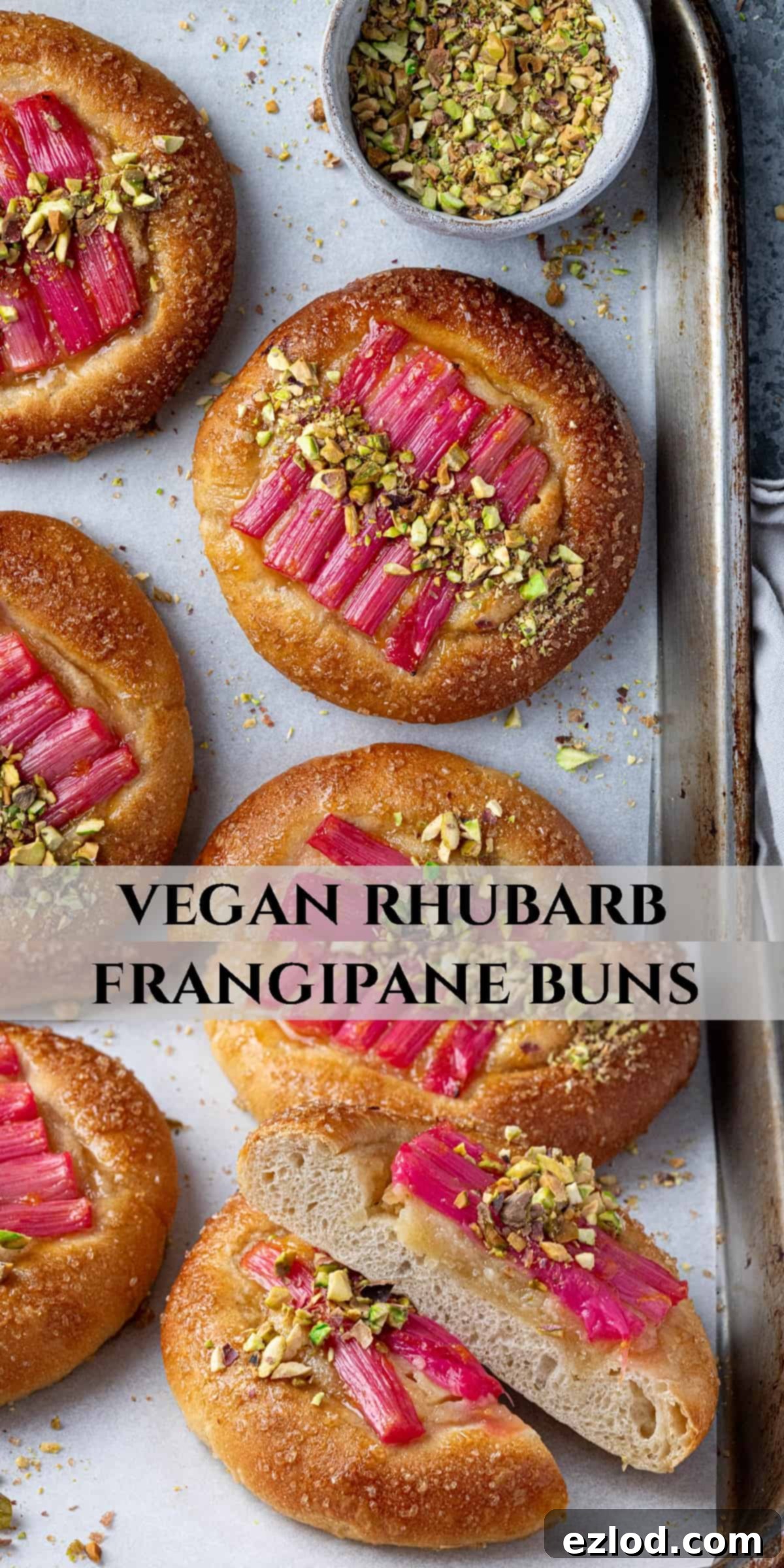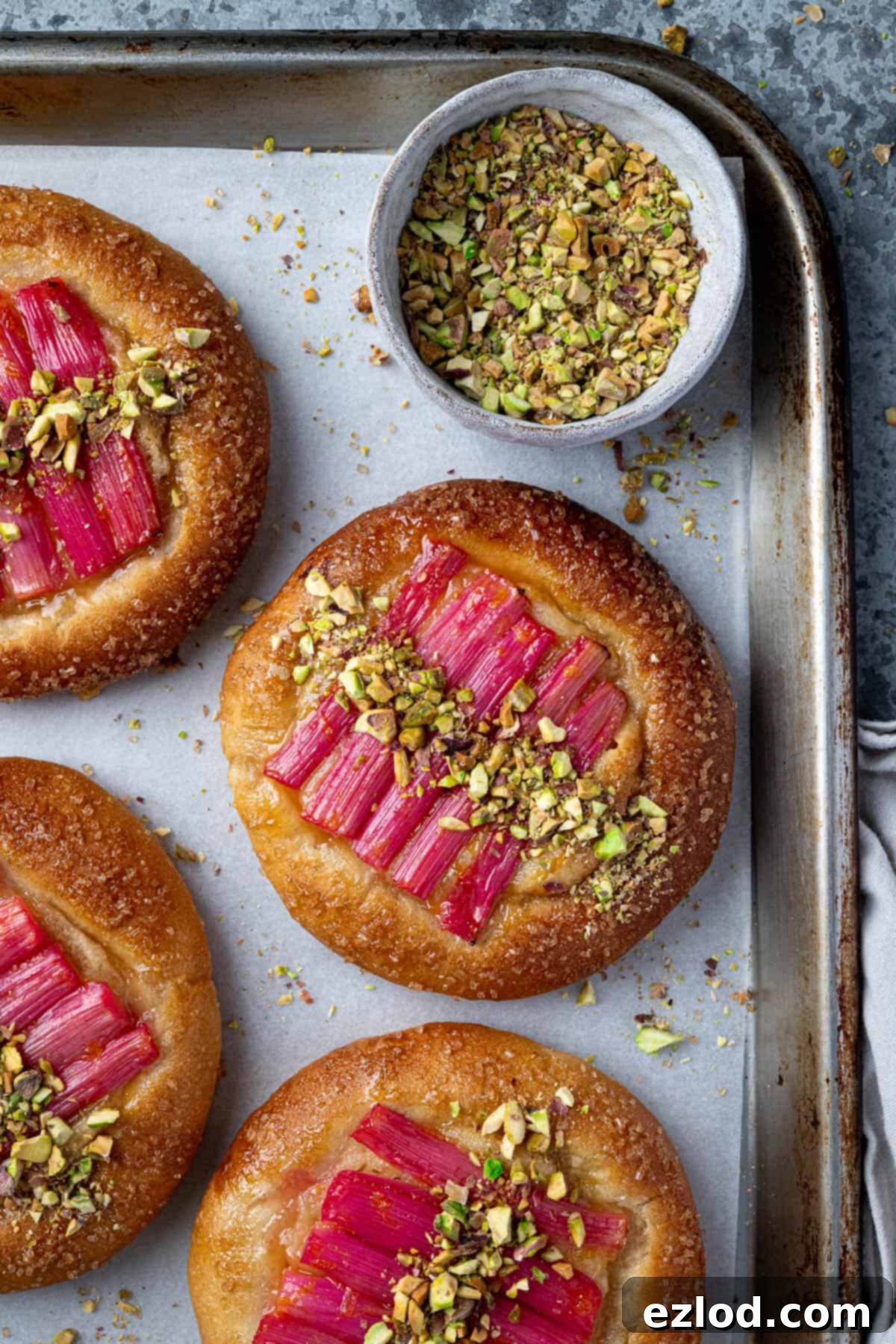Delicious Vegan Rhubarb Frangipane Buns: Your Ultimate Guide to Fluffy, Fruity Pastries
Prepare to be enchanted by these incredible Vegan Rhubarb Frangipane Buns – a truly delightful treat that combines the best of brioche-style bread with the elegance of almond frangipane and the vibrant tang of roasted rhubarb. Each individual bun is a testament to sophisticated baking, offering a perfect balance of textures and flavors. Imagine sinking your teeth into a remarkably soft, fluffy, brioche-like bread base, generously topped with a rich, creamy almond frangipane, and crowned with tender, beautifully roasted rhubarb pieces. This isn’t just a snack; it’s an experience, delivering both rich flavor and a pleasant lightness.
These buns are meticulously crafted to be richly flavored yet not overwhelmingly sweet, striking a harmonious balance that makes them an ideal choice for a luxurious breakfast, an impressive brunch centerpiece, or an elegant afternoon snack. What makes them even more remarkable is that they are entirely plant-based, proving unequivocally that vegan baking can be just as, if not more, decadent and satisfying. Their visual appeal alone, with vibrant colors and artful topping, makes them look like they’ve come straight from a high-end bakery, ready to brighten any table and impress any guest, whether vegan or not.
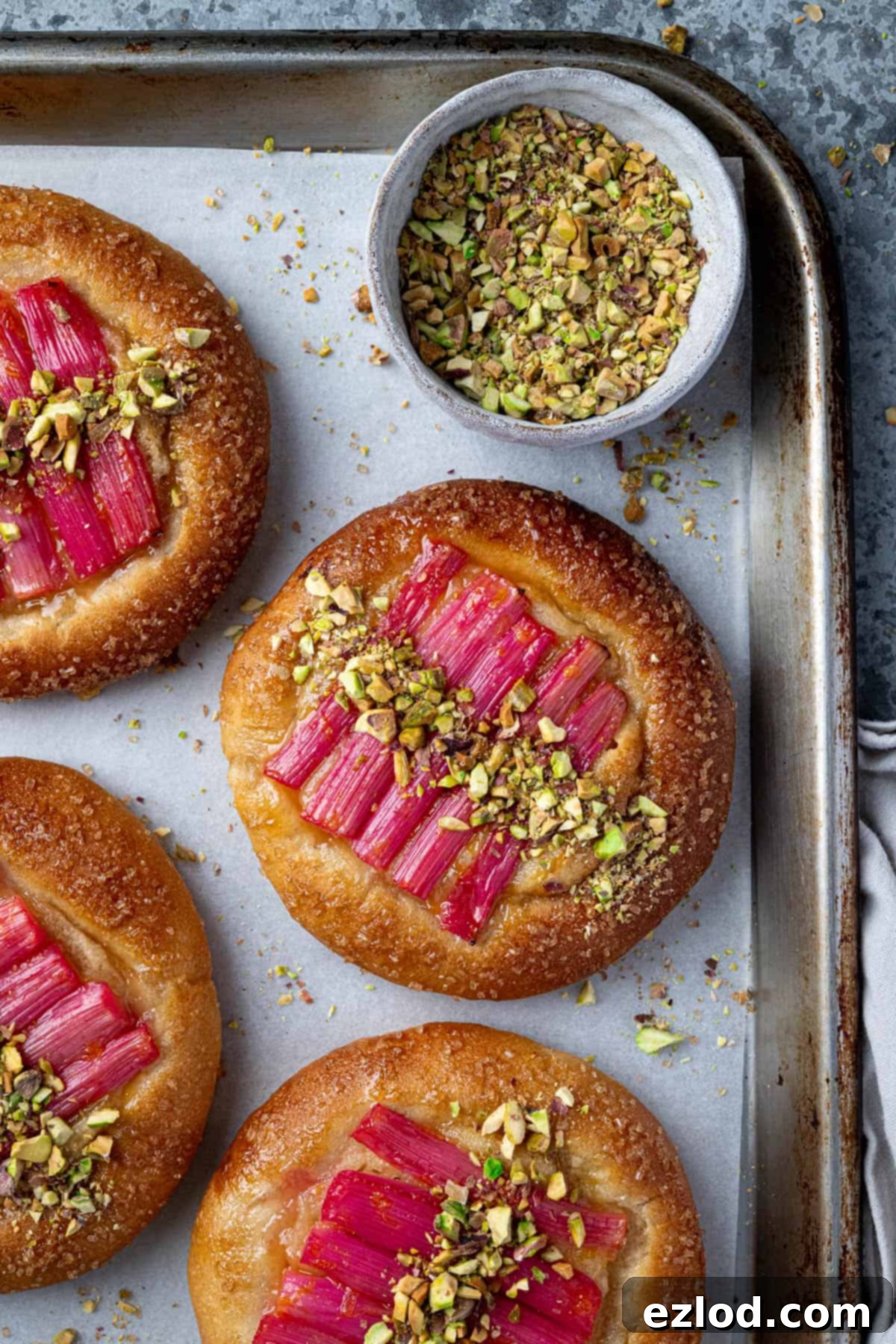
Creating these vegan rhubarb frangipane buns has been one of my most rewarding baking projects. Not only do they look stunning with their vibrant pink rhubarb against the golden-brown bread and creamy frangipane, but their taste is truly extraordinary. The secret to their incredibly soft and fluffy base lies in the use of a traditional Asian baking technique called tangzhong. This water-roux method gelatinizes the starches in the flour, allowing the dough to retain significantly more moisture, resulting in a wonderfully tender, brioche-like bread that stays fresh for longer, all while using far less fat than a classic brioche recipe. This makes it a lighter yet equally satisfying plant-based option for those who adore soft, enriched doughs.
Before baking, each individual bun is generously adorned with a luscious, eggless almond frangipane and vibrant, orange-infused roasted rhubarb. This combination is where the magic truly happens: the pillowy, soft bread base provides a comforting foundation, the rich and subtly sweet frangipane offers a creamy, nutty layer, and the sharp, tangy rhubarb cuts through with a burst of fruity freshness. Together, these elements create a symphony of complementary flavors and contrasting textures that is simply irresistible. The slight tartness of the rhubarb beautifully balances the richness of the frangipane, ensuring every bite is perfectly harmonious and never overly sweet.
For an extra touch of elegance and a pleasant textural contrast, a scattering of finely chopped pistachios is highly recommended. While entirely optional, the beautiful pairing of the vibrant pink rhubarb with the delicate green of the pistachios elevates these buns to a professional bakery standard, making them even more visually appealing. Beyond the aesthetics, pistachios add a subtle, satisfying crunch and a hint of nutty flavor that complements the soft bread and creamy filling wonderfully, enhancing the overall sensory experience. These delectable pastries are sure to become a cherished addition to your vegan baking repertoire, perfect for any special occasion or simply a luxurious everyday treat.
The visual inspiration for these unique buns comes from Edd Kimber’s renowned rhubarb and custard brioche tarts. It’s important to note, however, that while the concept of a brioche-style bun topped with fruit and a creamy filling is inspired, the underlying recipe for these vegan rhubarb frangipane buns is completely distinct. It has been uniquely crafted from scratch to be entirely plant-based and features our specific flavor profile and tangzhong dough method, offering a unique take on a classic idea.
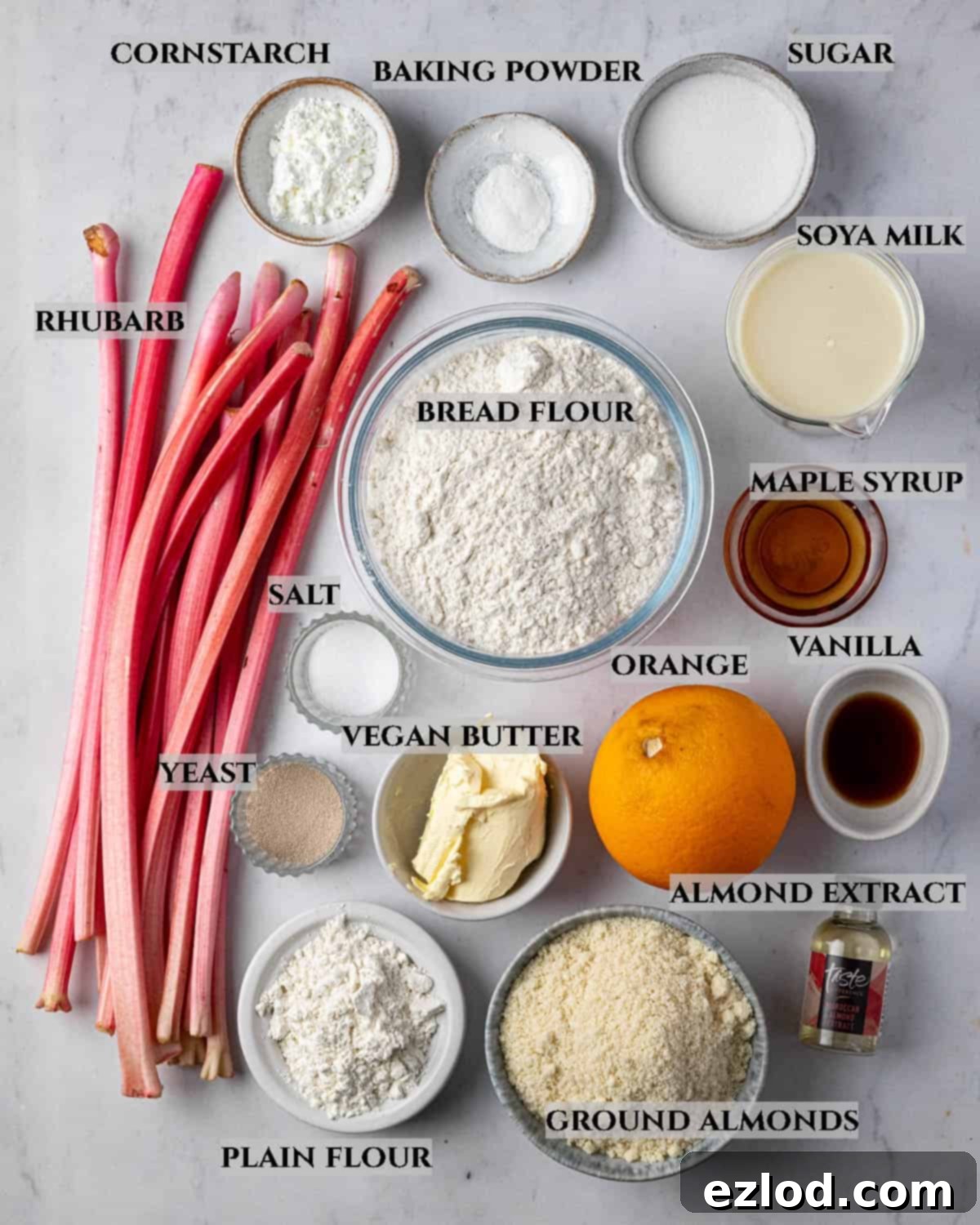
Essential Ingredient Details for Perfect Vegan Rhubarb Frangipane Buns
Understanding the role of each ingredient is key to successful baking, especially when working with a specialized recipe like these delightful vegan frangipane buns. Here’s a detailed look at what you’ll need and why, along with some helpful tips for substitutions:
Bread flour: This is a crucial component for achieving the signature soft, fluffy, and slightly chewy texture of our brioche-like dough. Bread flour has a higher protein content (typically 12-14%) compared to plain (all-purpose) flour, which allows for stronger gluten development. This results in a more elastic dough that can trap more air, yielding a lighter and more open crumb. While plain (all-purpose) flour can be used as a substitute, the texture of the finished buns won’t be quite as soft and chewy. I strongly advise against using wholemeal flour as its higher bran content will interfere with gluten development, making the buns noticeably denser and heavier, thus compromising the desired light texture.
Instant yeast: For convenience and reliability, I always opt for instant yeast in my bread recipes. Unlike active dry yeast, which typically requires activation in warm liquid before being added to dry ingredients, instant yeast can be mixed directly with the flour. This streamlines the process and ensures a consistent rise, making it perfect for both experienced bakers and those new to bread making. Ensure your yeast is fresh and within its expiration date for optimal results, as old yeast can significantly hinder your dough’s rise.
Salt: Never underestimate the power of salt in bread making! It’s not just for enhancing flavor; salt plays a vital role in regulating yeast activity, slowing down fermentation for better flavor development, and strengthening the gluten structure. Omitting salt will result in a bland-tasting bun with an uncontrolled, often too rapid, rise and a less desirable crumb texture, so ensure you include it in the specified amount.
Non-dairy milk: When it comes to plant-based baking, soy milk is my top recommendation. Its higher protein content (similar to dairy milk) contributes to a richer flavor and superior texture in baked goods, aiding in browning and tenderness. However, any variety of unsweetened non-dairy milk (such as almond, oat, or cashew milk) will work. Always opt for an unsweetened version to maintain precise control over the sugar levels in your recipe. If you have soy milk available, it’s definitely the preferred choice for its consistent and reliable results in enriched doughs.
Vegan butter: For optimal results in baking, especially in recipes where butter contributes significantly to structure and richness, I generally recommend using a block-style vegan butter for its firm consistency and higher fat content. However, for this particular brioche-like dough, a good quality tub variety (like Flora Original, popular in the UK) is perfectly acceptable, as long as it’s a full-fat spread and not one of the low-fat alternatives. Ensure the butter is softened, not melted, for proper incorporation into the dough, which is essential for achieving its characteristic richness and tender crumb.
Sugar: Caster sugar (also known as superfine sugar) or regular granulated sugar provides the necessary sweetness and also plays an important role in activating the yeast, contributing to a tender crumb and a beautiful golden crust. It is essential to use granular sugar for this recipe; liquid sugars like maple syrup or agave, or artificial sweeteners, will drastically alter the dough’s hydration and chemistry, leading to unpredictable results and a compromised texture. Stick to the recommended type of sugar for best outcomes.
Ground almonds: This ingredient forms the delightful, rich, and nutty base of the frangipane filling. In the UK, it’s commonly called ground almonds, while in the US, it’s often referred to as almond flour. Ensure you use finely ground almonds (not almond meal with skins) for a smooth and luxurious frangipane texture. It imparts a naturally sweet, nutty flavor and a delicate structure to the topping, making it incredibly moist and flavorful.
Cornstarch: To help the frangipane set beautifully and achieve its creamy, pudding-like consistency without eggs, a combination of plain flour and cornflour (cornstarch in the US) is used. Cornstarch acts as an excellent thickening agent, ensuring the frangipane holds its shape perfectly and provides a delightful, tender contrast to the soft bread and tangy rhubarb. It prevents the filling from becoming too runny during baking.
Rhubarb: For that striking, vibrant pink color and a natural sweetness with a pleasant tart kick, forced rhubarb is the ideal choice. Its delicate flavor and beautiful hue make these buns visually appealing and delicious, signaling the arrival of spring. If forced rhubarb is not available, regular field-grown rhubarb can certainly be used, though its color might be greener or paler, and its flavor a bit sharper, which might necessitate a touch more sugar during roasting to balance the tartness.
Orange: The addition of fresh orange zest and juice during the rhubarb roasting process is transformative. It infuses the rhubarb with a bright, aromatic, and citrusy flavor that perfectly complements its tartness, elevating the fruit’s natural taste. For an even more intense citrus punch and a stunning deep red hue, especially if you’re aiming for maximum visual impact, using blood orange would be an excellent, albeit optional, choice. The subtle bitterness of the zest also adds complexity.
Demerara sugar: This is an optional but highly recommended topping that adds a wonderful crunch and a subtle, molasses-rich caramel note to the buns. Sprinkling demerara (also widely known as turbinado) sugar on the exposed dough rim before baking creates a beautiful glistening finish and a delightful textural contrast against the soft bread. It’s often that small, finishing touch that elevates a homemade bun to a truly bakery-worthy masterpiece, adding both visual appeal and a delicious textural element.
As a final flourish, and purely for aesthetic delight and a slight nutty flavor, I often decorate my buns with some finely chopped roasted pistachios after they come out of the oven. The combination of the vibrant pink rhubarb and the subtle green of the pistachios is incredibly pretty and adds a gourmet touch that truly makes these buns shine. This is, of course, entirely optional, but it certainly enhances the visual appeal and provides a delicate textural counterpoint to the soft filling.
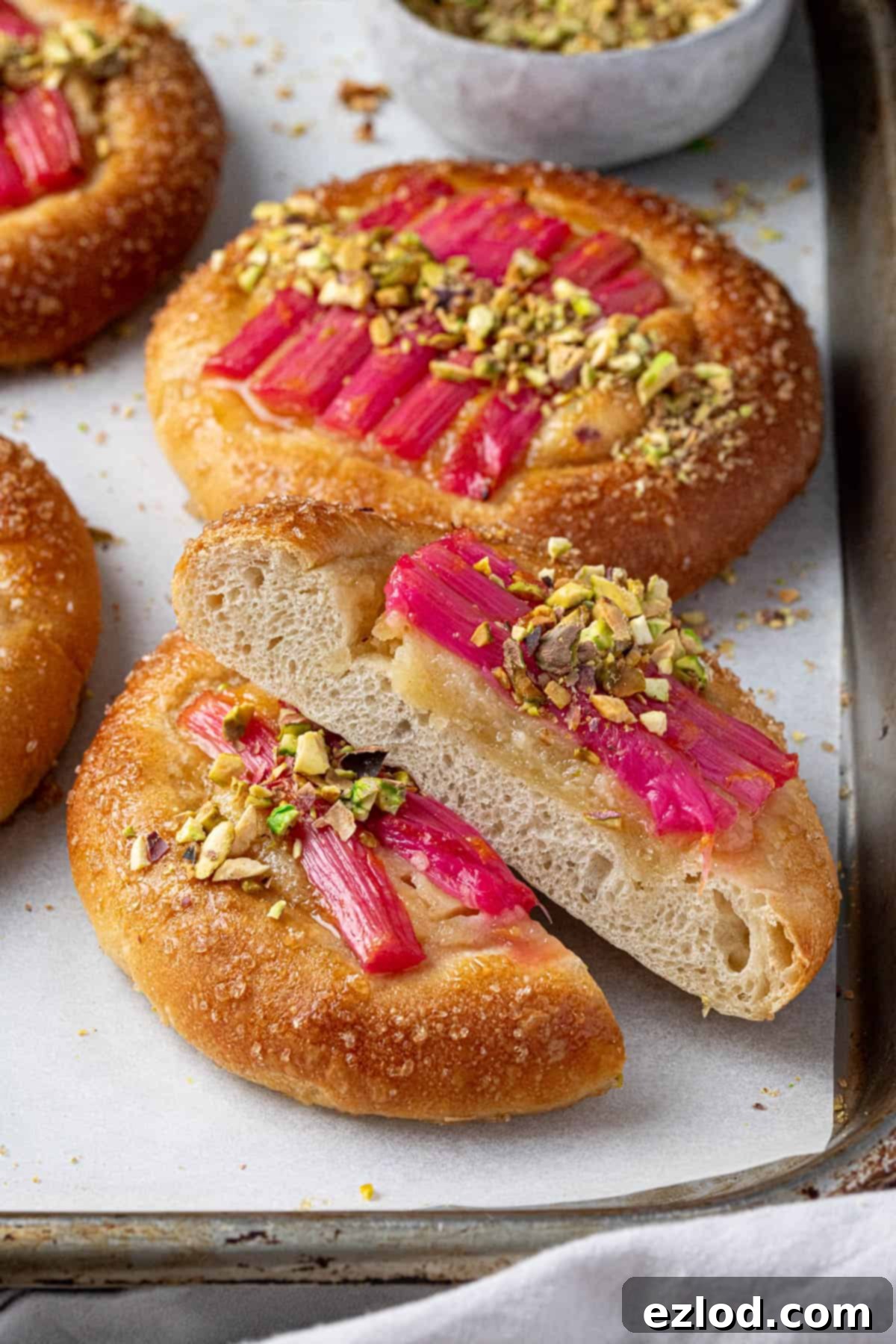
Step-by-Step Guide: How To Make These Exquisite Vegan Rhubarb Frangipane Buns
(For precise measurements and detailed instructions, please refer to the comprehensive recipe card located at the bottom of this page.)
Creating these beautiful vegan rhubarb frangipane buns involves a few key stages, each contributing significantly to their overall perfection. Follow these steps carefully for the best possible results, paying attention to the details for a truly bakery-worthy outcome:
Step 1: Prepare the Tangzhong. Begin by making the tangzhong, the secret to the incredibly soft texture of these buns. In a small saucepan, combine the specified amount of white bread flour and gradually whisk in the non-dairy milk. This slow, gradual addition is crucial to prevent lumps and ensures you achieve a perfectly smooth mixture. Place the pan over a medium-low heat and continue to whisk constantly. Within a few minutes, you will notice the mixture thickening to a thick paste or pudding-like consistency. This process gelatinizes the starches in the flour, allowing the dough to absorb and retain significantly more moisture, which results in a softer, more tender bread that remains fresh for longer. Once thickened, immediately remove the pan from the heat and set aside.
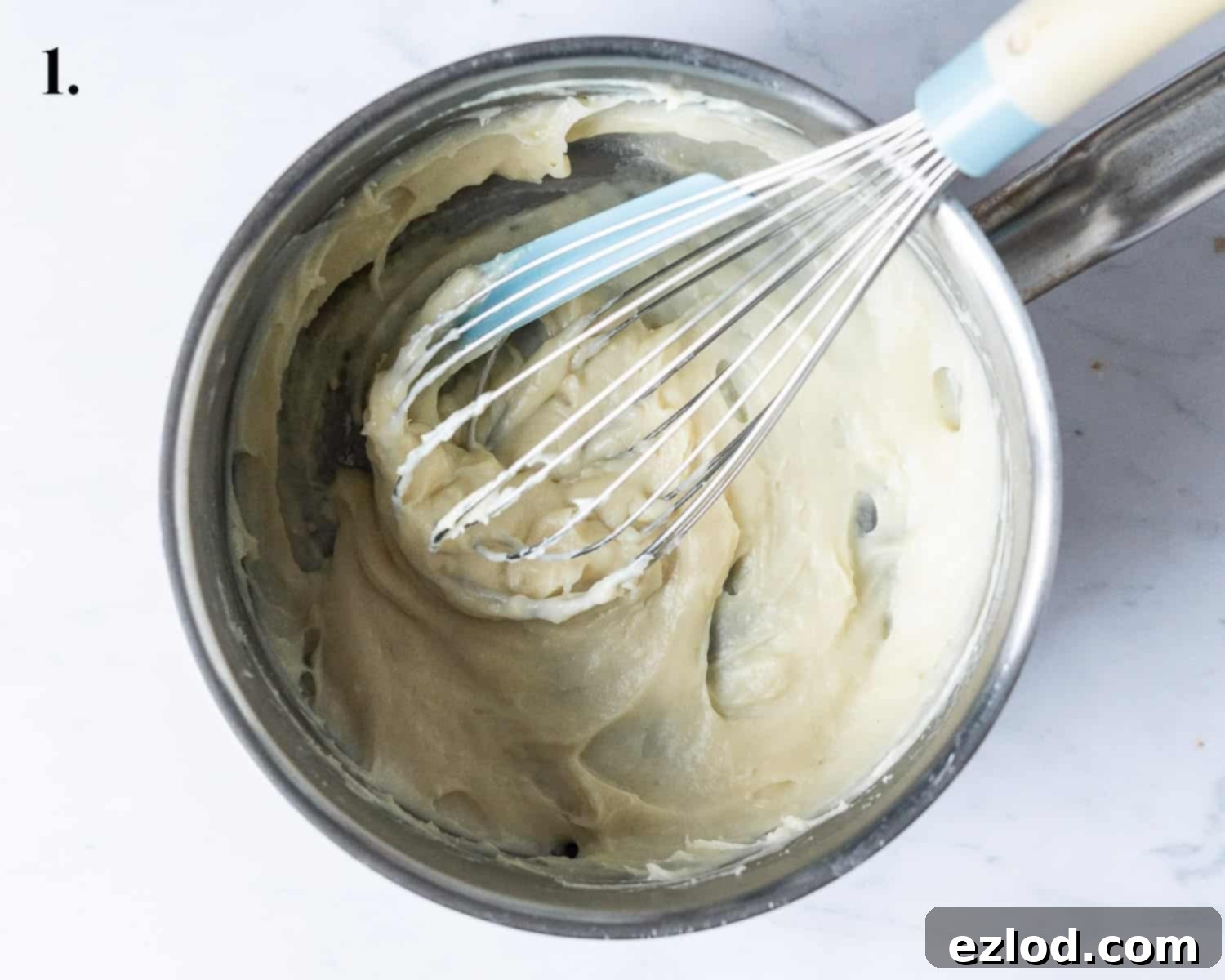
Step 2: Develop the Dough. Scrape the prepared tangzhong into the bowl of a stand mixer fitted with a dough hook attachment. Immediately pour the remaining cold non-dairy milk over the tangzhong. The cold milk is crucial at this stage as it helps to quickly cool down the warm tangzhong, preventing it from being too hot when the yeast is added, which could otherwise kill the active yeast. Next, add the sugar, vanilla extract, salt, bread flour, and finally the instant yeast. Stir these ingredients briefly on a low speed until they just come together to form a rough, shaggy dough. Then, increase the stand mixer speed to medium and knead the dough for approximately 10 minutes until it becomes beautifully smooth, elastic, and visibly stretchy. At this point, add the softened vegan butter and continue kneading for another 5 minutes. The butter should be fully incorporated, leaving you with a smooth, elastic dough that is no longer greasy to the touch. This extensive kneading process is vital for properly developing the gluten structure that gives these buns their characteristic fluffiness and chew.
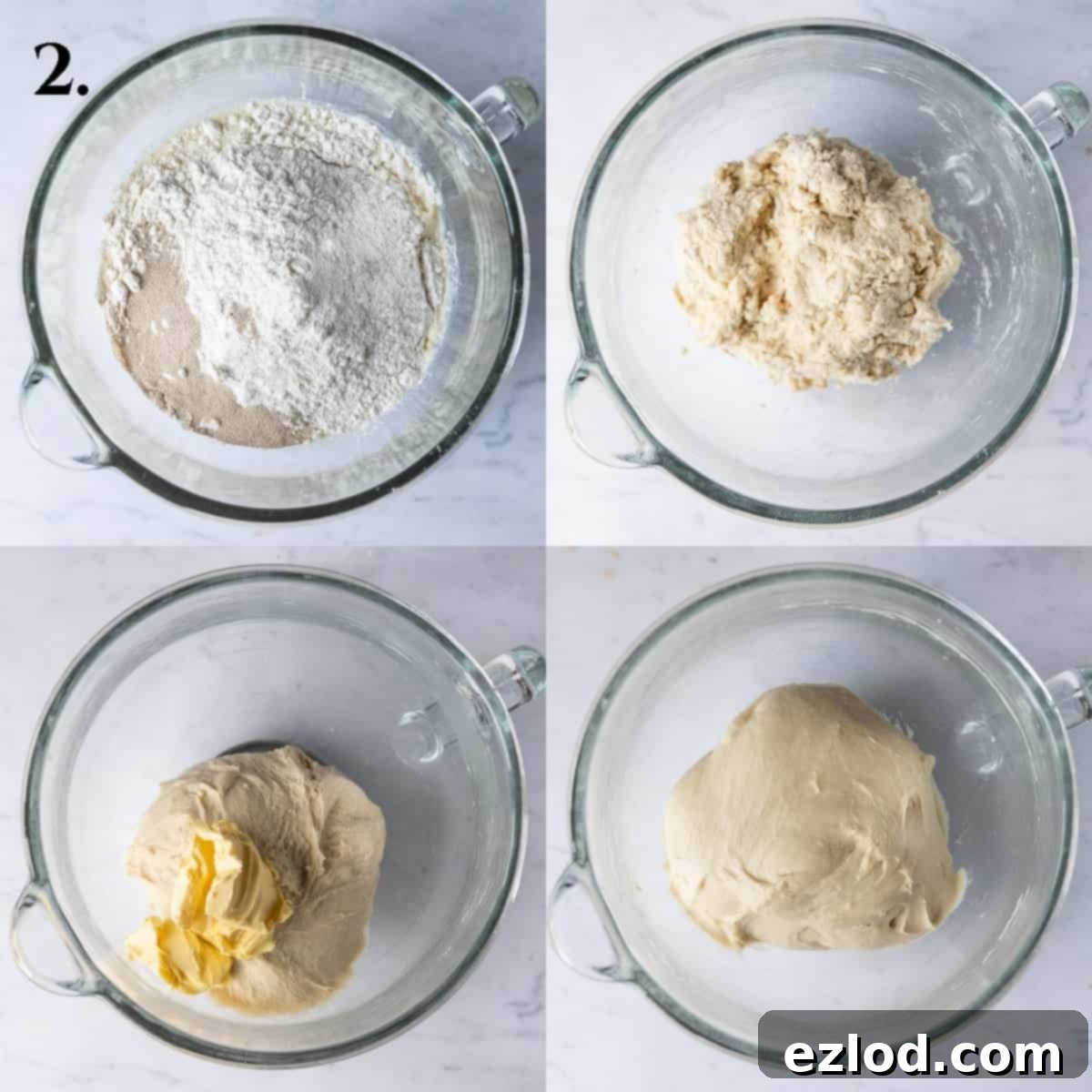
Step 3: First Rise (Bulk Fermentation). Once the dough is perfectly kneaded to a smooth, elastic consistency, carefully transfer it to a lightly oiled bowl, ensuring it’s rotated to coat all sides with oil to prevent sticking during the rise. Cover the bowl tightly with plastic wrap or a clean kitchen towel to prevent it from drying out. Place the dough in a warm spot in your kitchen to rise for its first fermentation. This bulk fermentation typically takes between 1 to 2 hours, or until the dough has visibly doubled in size. The exact timing will depend on the ambient temperature of your kitchen – warmer spots will facilitate a quicker rise. Alternatively, for a deeper flavor development and to better manage your baking schedule, you can place the dough in the fridge to rise slowly overnight (8-12 hours).
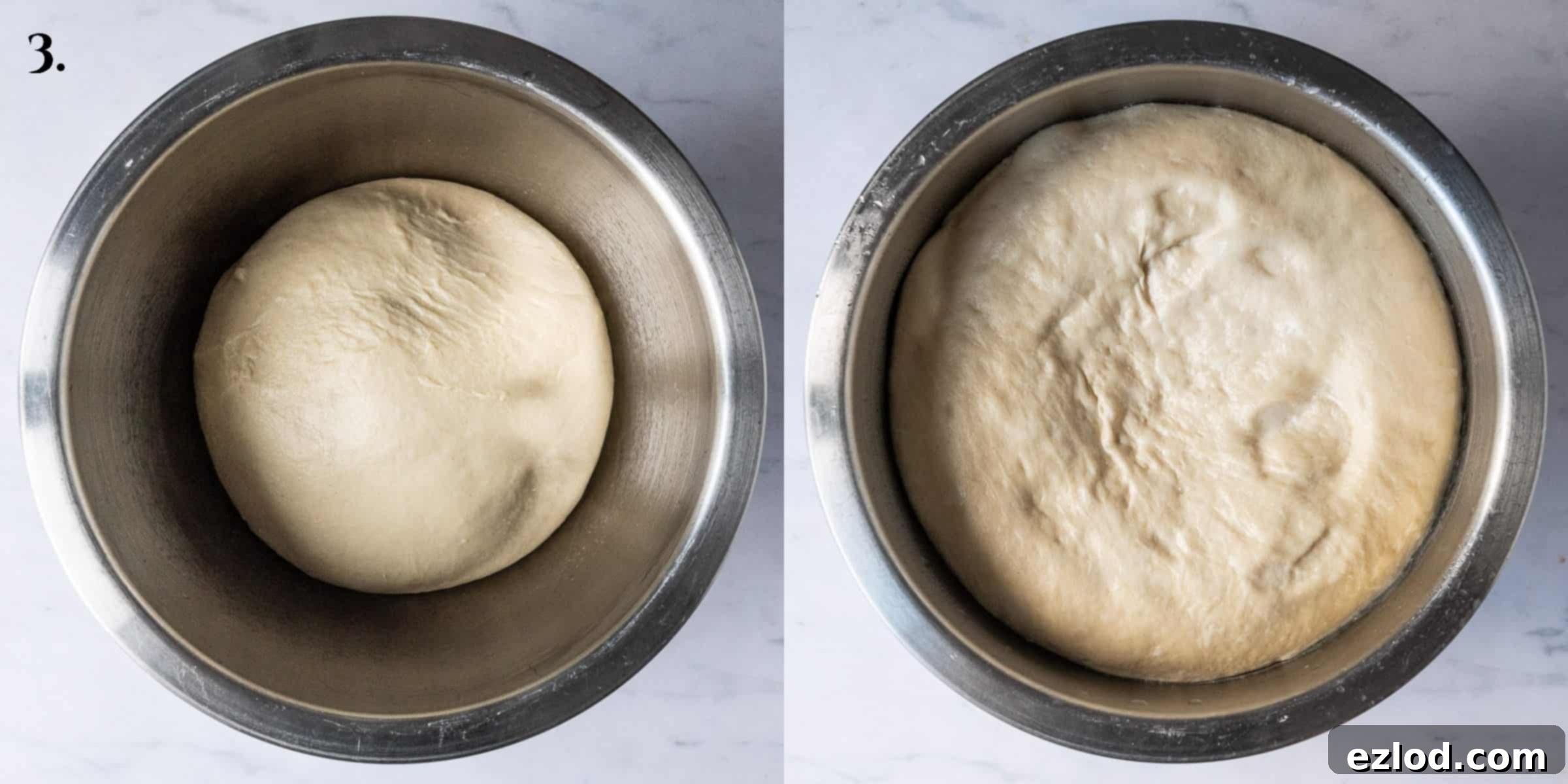
Step 4: Roast the Rhubarb. While your dough is undergoing its first rise, prepare the vibrant and tangy roasted rhubarb topping. Preheat your oven to 180℃ (160℃ fan/350℉/gas mark 4). Cut the rhubarb stalks into approximately 7cm (2.5-3 inch) long pieces and arrange them in a single layer in a roasting tin, ensuring they are not overcrowded for even roasting. Sprinkle them generously with caster or granulated sugar and pour the fresh orange juice over them. Roast for about 10 minutes, or until the rhubarb has softened slightly but still largely retains its shape. It’s crucial not to overcook it at this stage, as it will undergo further baking on the buns. Once perfectly roasted, set the rhubarb aside to cool completely, making sure to reserve any delicious, accumulated juices from the roasting tin for later use.
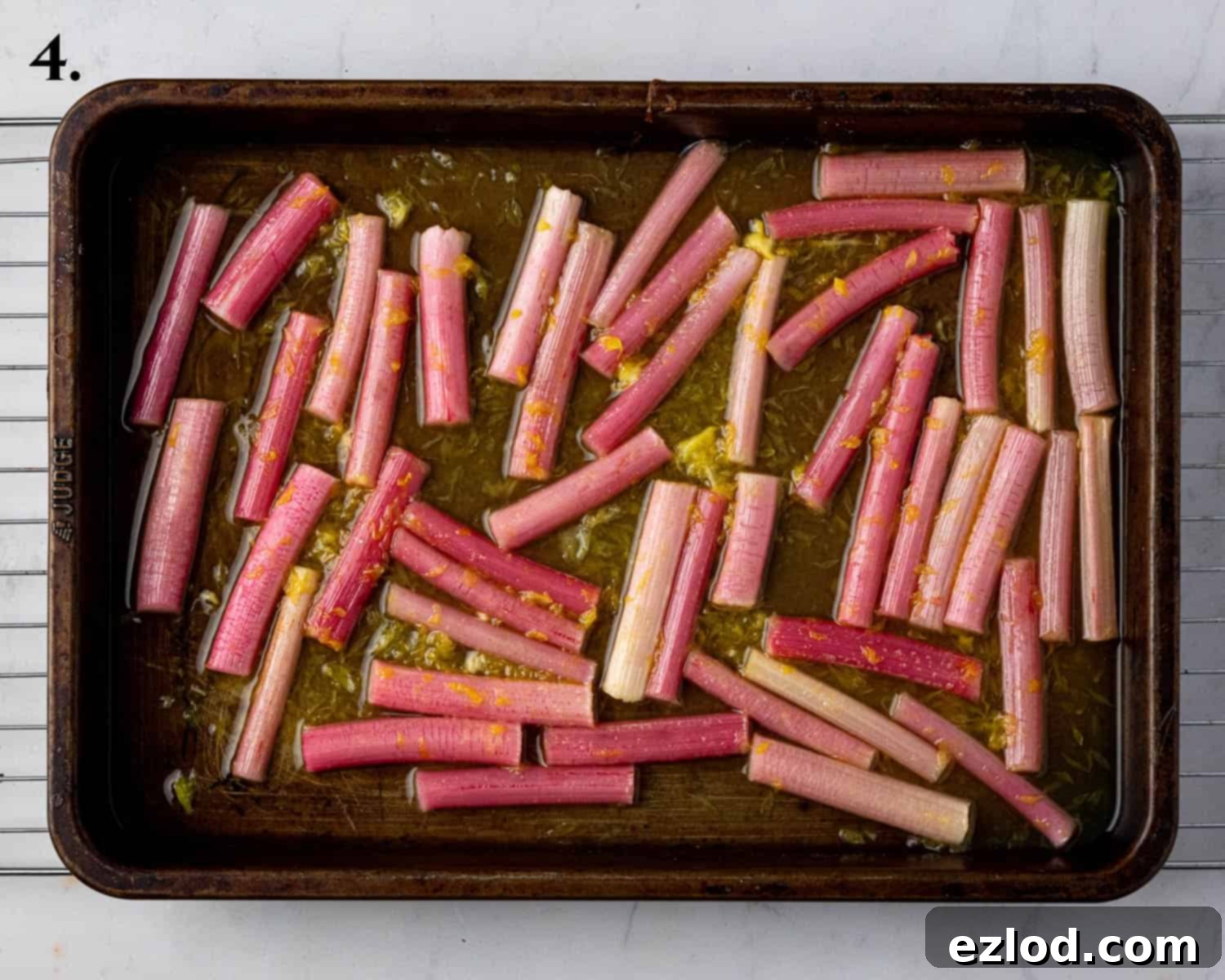
Step 5: Shape the Buns. Once the dough has successfully doubled in size during its first rise, gently punch it down to release the trapped air. Briefly knead it on a lightly floured surface for about 30 seconds to knock out any large air bubbles and create an even texture. Divide the dough into 10 equal pieces. For optimal consistency and uniform baking, it’s highly recommended to use a digital kitchen scale at this stage to ensure each piece weighs the same. Roll each piece into a smooth, tight ball. Then, using your hands, gently flatten each ball into a disc, approximately 10cm (4 inches) wide. To create the perfect hollow for the frangipane and rhubarb, use your fingers or the base of a small glass to flatten the central section of each disc even further, leaving a distinct, raised rim of about 2 cm (¾ inch) around the edge. This rim will act as a barrier to hold the delicious fillings securely in place during baking.
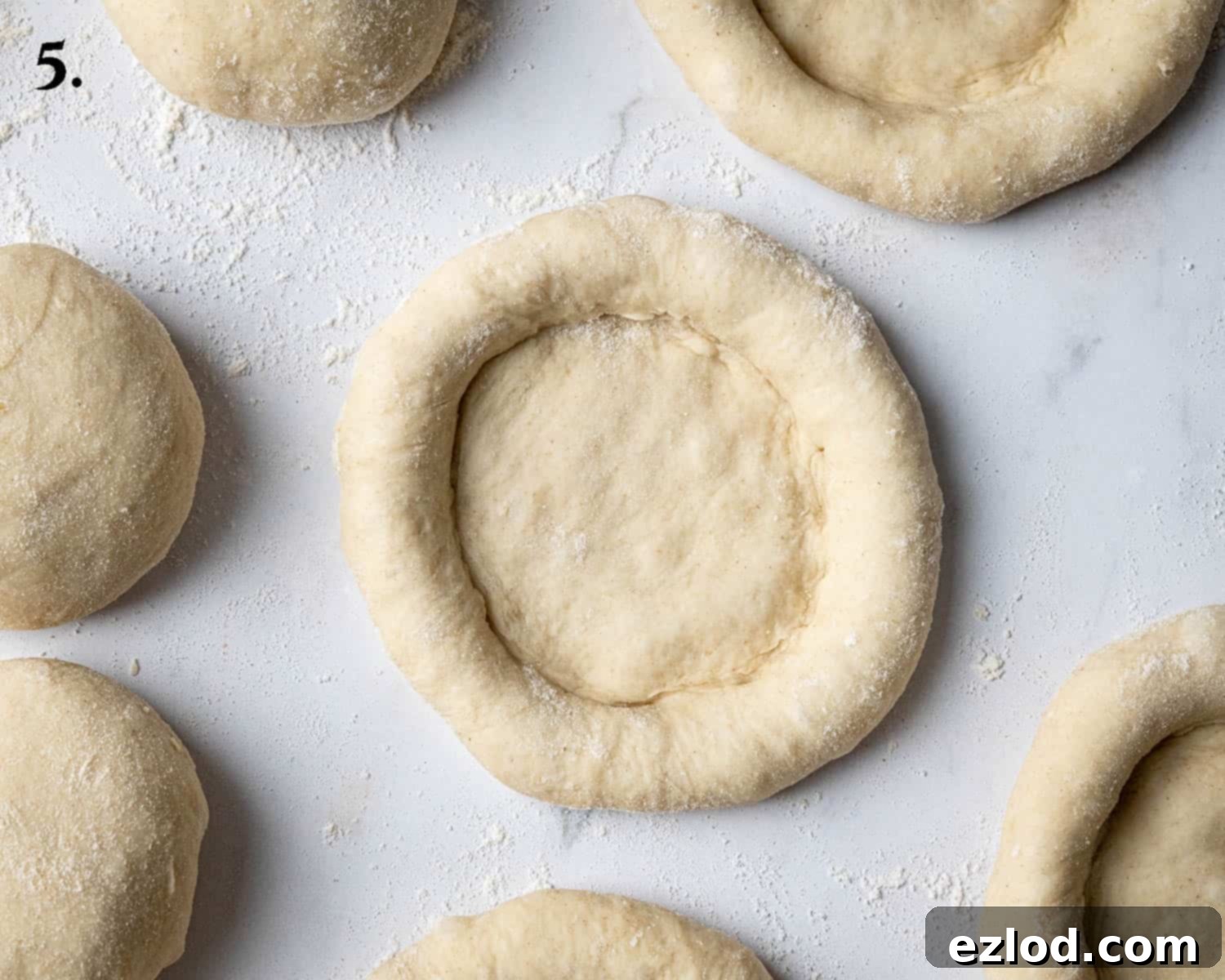
Step 6: Second Rise (Proofing). Carefully place the shaped dough discs onto two lined baking sheets, ensuring they are well spaced apart to allow ample room for expansion during this second rise (proofing) and subsequent baking. Loosely cover the baking sheets with plastic wrap or a light kitchen towel to prevent the dough from drying out. Allow the buns to rise again in a warm spot for about 30-45 minutes, or until they look visibly puffy and have increased significantly in size. A reliable way to test for readiness is the “poke test”: gently press the dough with your finger; if it springs back slowly and leaves a slight indentation, it’s perfectly proofed and ready for the next step. If it springs back quickly, it needs a little more time. If, however, the dough deflates when poked, it has unfortunately over-proofed, so keep a close eye on them during this crucial stage!
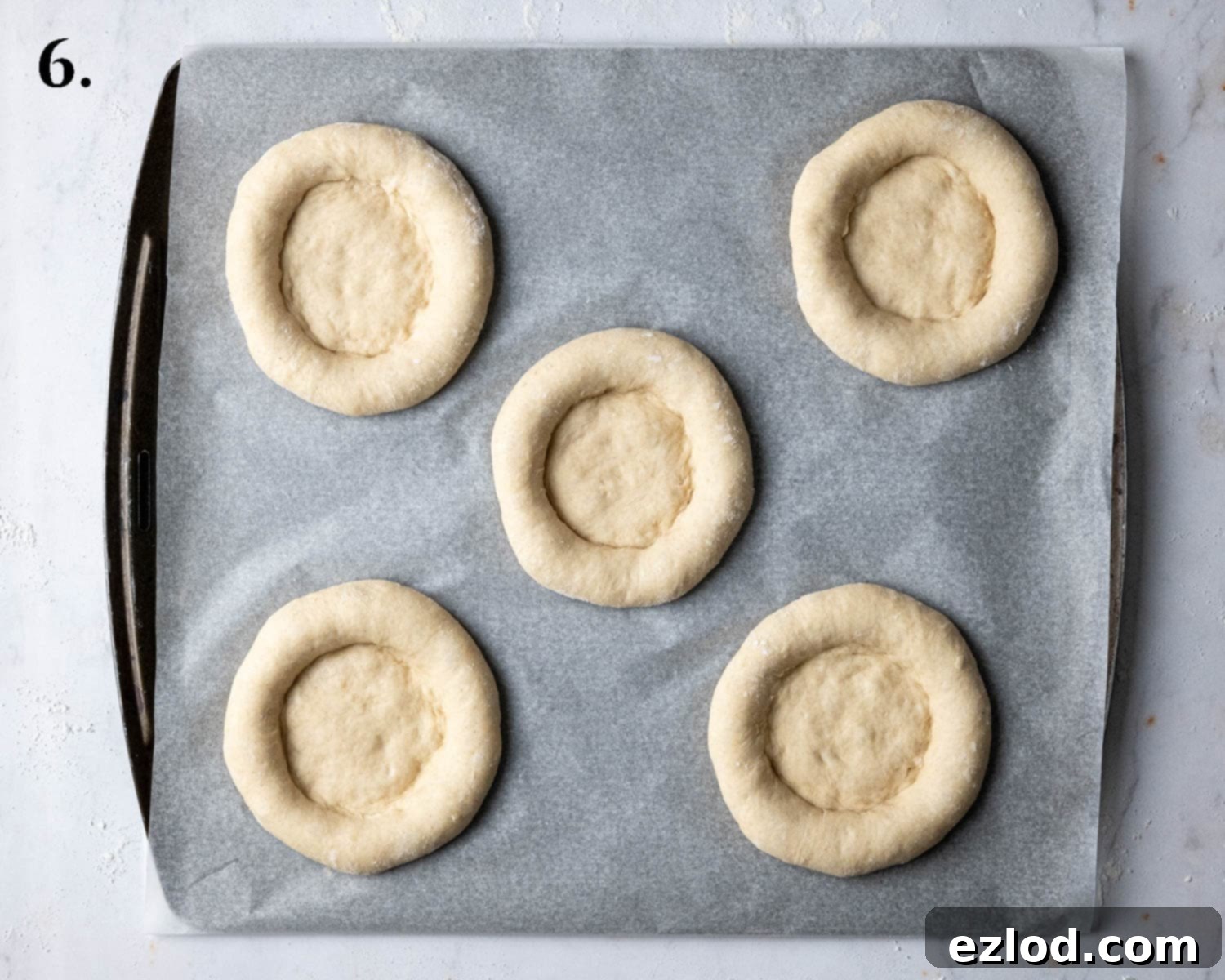
Step 7: Prepare the Frangipane. While your buns are undergoing their second rise, prepare the luscious, creamy almond frangipane. In a medium-sized mixing bowl, combine the ground almonds (almond flour), plain (all-purpose) flour, cornflour (cornstarch), baking powder, and caster or granulated sugar. Whisk these dry ingredients together thoroughly to ensure they are well combined and there are no lumps. Then, add the melted vegan block butter, non-dairy milk, and almond extract. Stir vigorously with a balloon whisk until all ingredients are thoroughly incorporated and you have a smooth, homogeneous, and creamy frangipane mixture. This eggless version beautifully captures all the richness and delicate flavor of traditional frangipane, providing a perfect plant-based alternative.
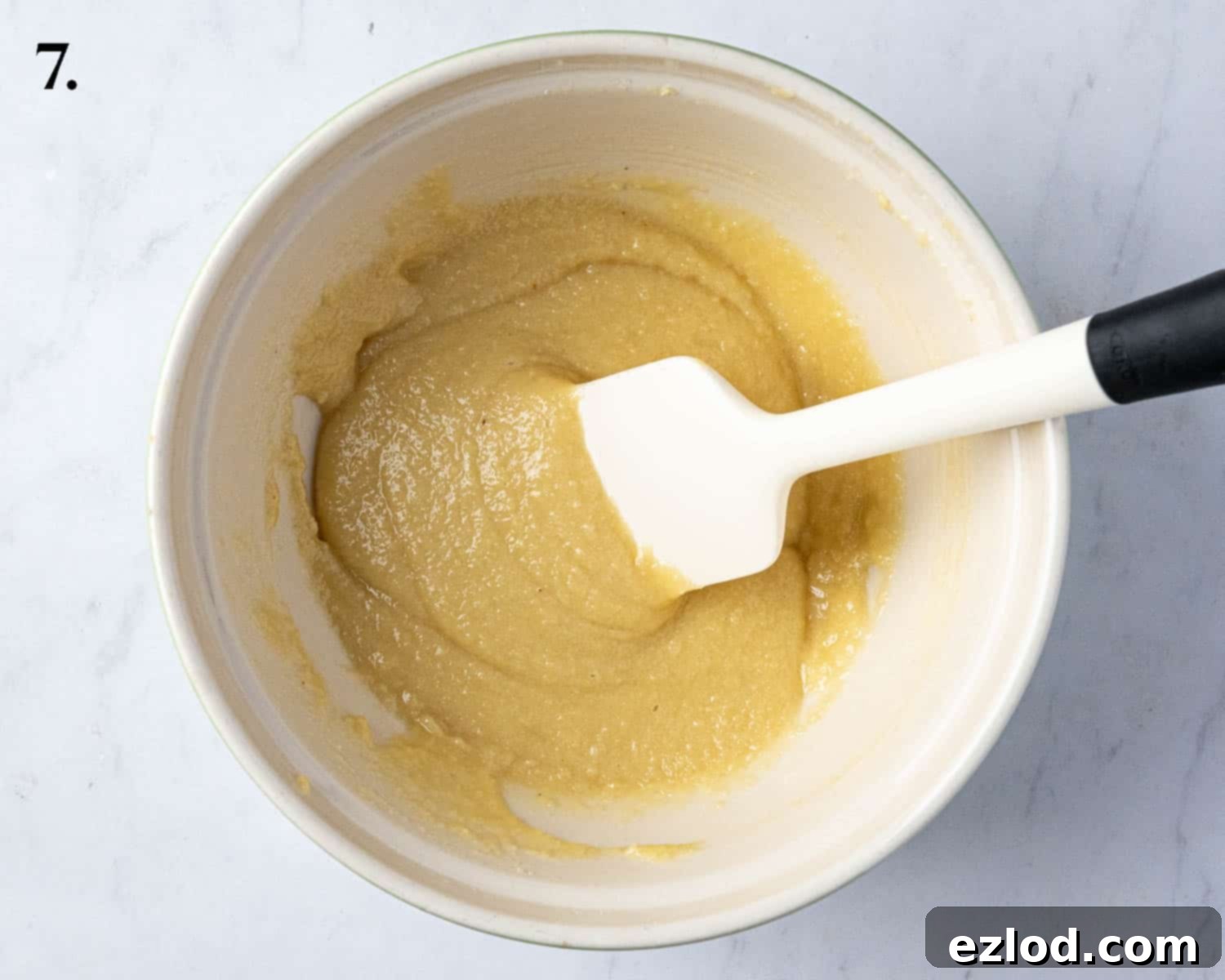
Step 8: Fill the Buns. Once the buns have completed their second rise and are beautifully puffy, indicating they are ready for baking, it’s time to add the delicious frangipane filling. Carefully divide the prepared frangipane mixture evenly among the hollowed-out centers of each bun. Using a spoon or a small offset spatula, gently spread the frangipane level with the raised dough rim, ensuring an even layer across all buns. This rich, creamy layer will bake into a wonderfully tender and flavorful topping, providing a delightful contrast to the soft bread base and the tangy fruit.
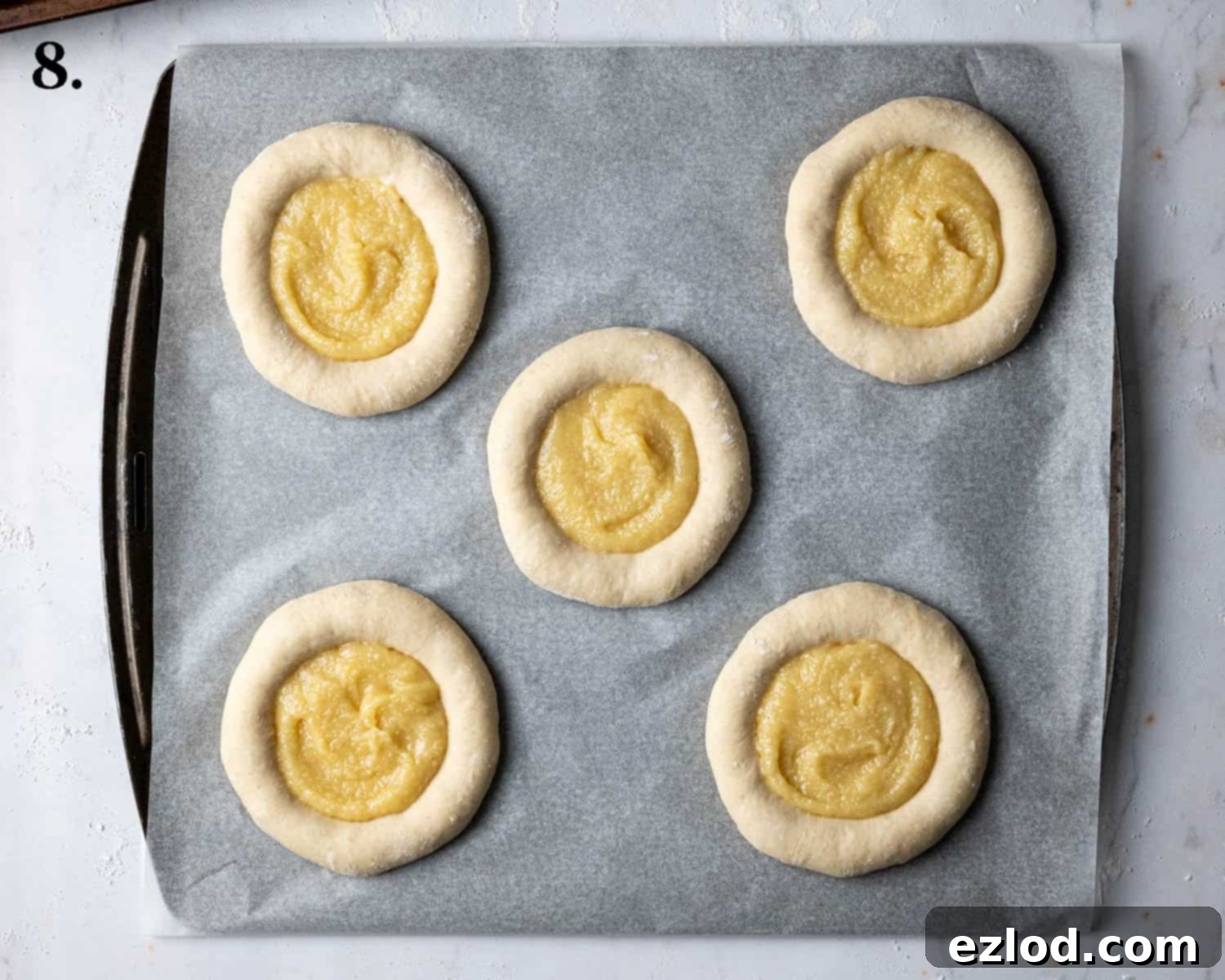
Step 9: Top and Garnish. Now, artfully arrange the cooled, roasted rhubarb pieces on top of the frangipane in each bun. Be creative with your arrangement for an appealing presentation – a few pieces laid diagonally or fanned out can look particularly stunning. Remember to have the delicious rhubarb juices from the roasting tin reserved for later use. In a small bowl, whisk together the non-dairy milk and maple syrup. Gently brush this mixture over the exposed dough rim of each bun – this “egg wash” alternative will help them achieve a beautiful golden-brown color and a lovely sheen during baking. Finally, generously sprinkle demerara sugar over the brushed dough for that irresistible crunch and shimmer, adding another layer of texture and sweetness.
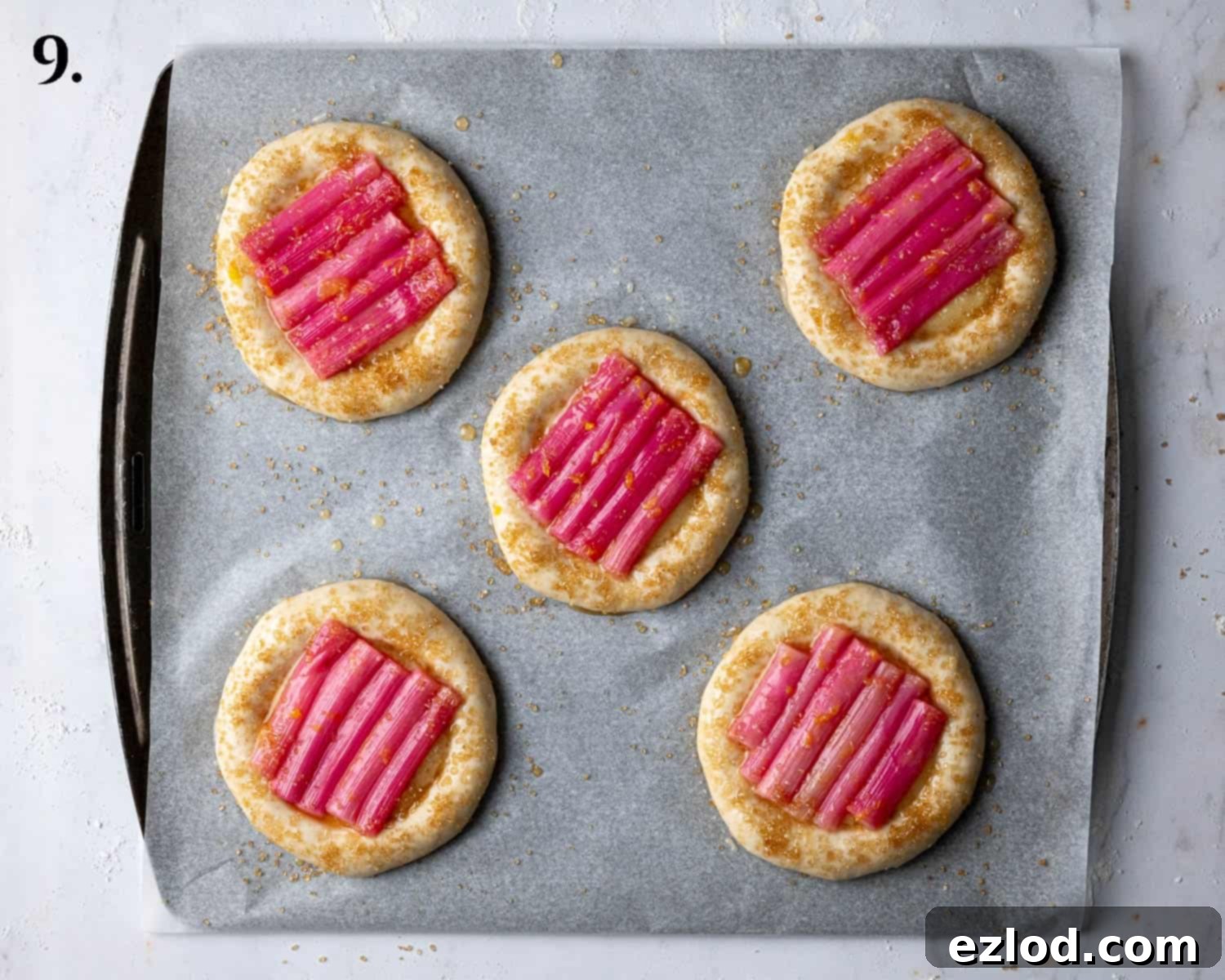
Step 10: Bake to Perfection. Transfer the baking sheets with your carefully prepared buns to the preheated oven. Bake for approximately 20-25 minutes, or until the buns are beautifully risen, golden brown around the edges, and the frangipane filling is set and lightly colored. Keep a close eye on them towards the end of baking to prevent over-browning, especially if your oven has hot spots. While the buns are baking, take the reserved rhubarb juices and pour them into a small saucepan. Bring to a gentle simmer over medium-low heat and cook for a few minutes until the liquid has reduced slightly and thickened into a light, glossy syrup. This syrup will add an extra layer of concentrated rhubarb flavor and a beautiful sheen to the finished buns.
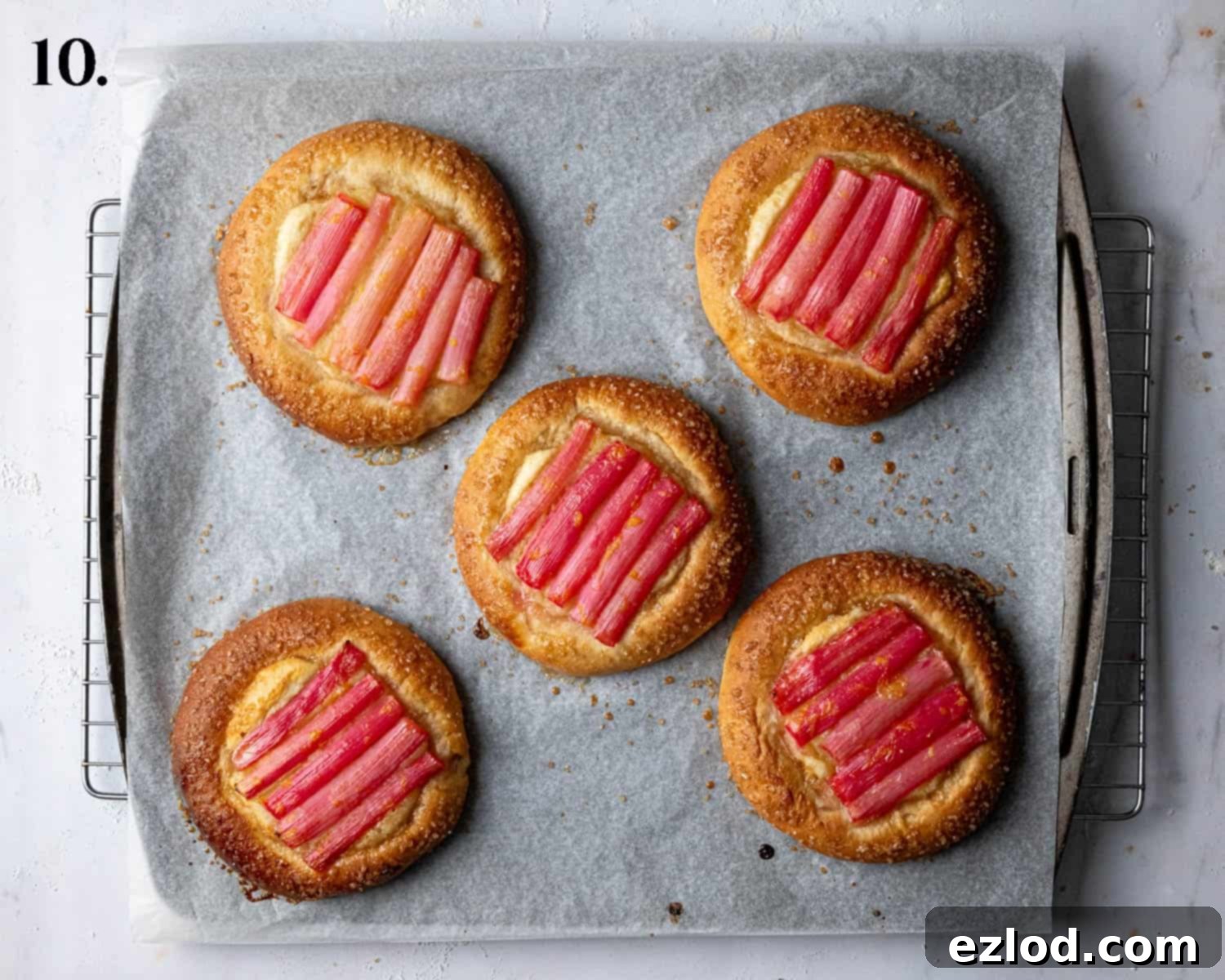
Once baked to golden perfection, gently slide the warm buns onto a wire cooling rack. While they are still warm, lightly brush the roasted rhubarb topping with the reduced syrup. This step adds a beautiful gloss and enhances the fruit’s flavor. If desired, sprinkle with finely chopped roasted pistachios for an added touch of color, texture, and nutty flavor. These vegan rhubarb frangipane buns are undeniably at their absolute best when enjoyed fresh from the oven, when the bread is at its fluffiest and the frangipane is perfectly tender and warm. Serve them immediately for the ultimate indulgence!
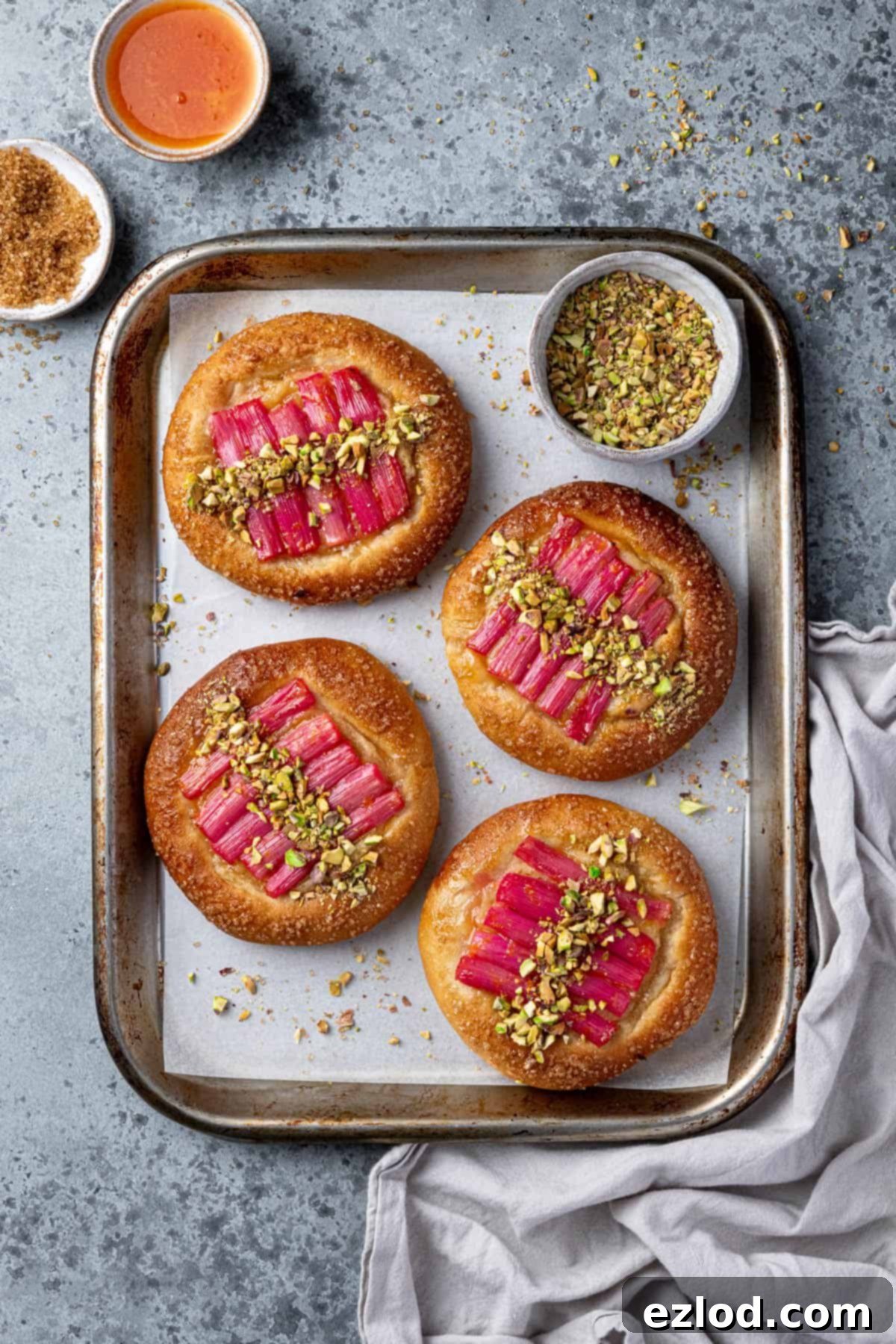
Top Tips for Baking Flawless Vegan Rhubarb Frangipane Buns
Achieving bakery-quality vegan buns at home is entirely possible with a few expert tips and careful attention to detail. Follow these suggestions to ensure your vegan rhubarb frangipane buns turn out perfectly soft, flavorful, and beautifully presented every single time:
- Embrace a Digital Scale for Accuracy: As with virtually all my baking recipes, I cannot stress enough the paramount importance of using metric measurements with a digital kitchen scale rather than volumetric cup conversions. Cups are notoriously inaccurate and can lead to significant inconsistencies in your baking. A scale provides precise measurements, which is fundamental for achieving better, more consistent baking outcomes, especially with delicate enriched doughs like brioche, and often results in a cleaner, less messy workflow!
- Check Your Yeast’s Vitality: Yeast is a living organism, and its activity is absolutely crucial for a successful rise. Always make it a habit to check the expiration date on your yeast packet. Old or inactive yeast is a very common culprit for doughs that fail to rise adequately, resulting in dense, heavy, and disappointing buns. If you’re ever in doubt about your yeast’s viability, you can perform a quick test by blooming a small amount in warm (not hot!) non-dairy milk with a pinch of sugar; it should become foamy and active within 5-10 minutes.
- Mind the Temperature for Rising: The rising time for doughs is highly dependent on the ambient temperature of your kitchen. In a warm environment, your dough will typically proof much faster than in a cold one. Instead of strictly adhering to the clock, learn to rely on visual cues and the “poke test” (as described in Step 6) to determine if your dough is ready. You can create a consistently warm environment by placing the dough bowl in an unheated oven with just the oven light on, or near a sunny window, ensuring it’s not exposed to drafts.
- Avoid Overcooking the Rhubarb: When roasting the rhubarb in Step 4, be mindful not to overcook it. The ideal goal is to achieve softened pieces that still largely hold their shape and structure, making them easy to arrange beautifully and elegantly on top of the frangipane. Overcooked rhubarb will become mushy and disintegrated, which can be challenging to work with and will detract from the visual appeal and textural integrity of the buns. A slight firmness is perfectly acceptable, as it will soften further during the final bake.
- Overnight Rise for Enhanced Flavor: For a deeper, more complex flavor profile and to significantly better manage your baking schedule, consider allowing the dough to undergo its first rise (bulk fermentation) overnight in the refrigerator. The cold temperature slows down the yeast activity, allowing for a longer, slower fermentation which develops more nuanced and rich flavors in the bread, similar to sourdough. This method also conveniently breaks up the workload, making the actual baking day less strenuous and more enjoyable.
- Enjoy Fresh, or Reheat Thoughtfully: These vegan rhubarb frangipane buns are undeniably at their absolute best when enjoyed on the day they are baked, while still warm and wonderfully fresh. The bread is fluffiest and the frangipane most tender at this point. However, they will remain delightfully delicious for a couple more days when stored correctly. If serving on subsequent days, a quick refresh in a low oven (around 150°C/300°F) for 5-10 minutes, or a brief zap in the microwave (10-20 seconds), will beautifully revive their softness and warmth, making them almost as good as fresh.
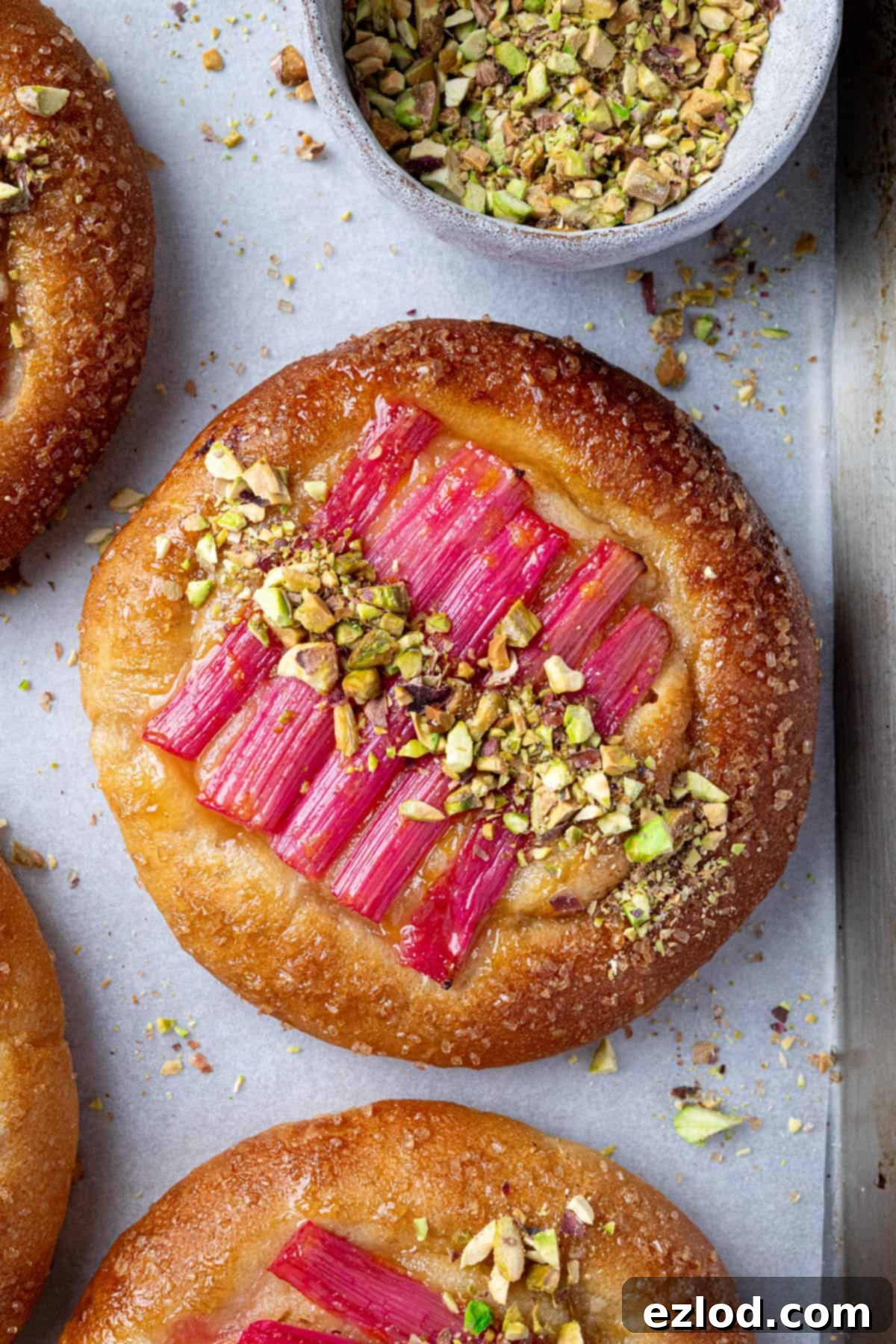
Frequently Asked Questions (FAQ’s) About Vegan Rhubarb Frangipane Buns
To maintain their peak freshness and delightful texture, it’s best to store your baked vegan rhubarb frangipane buns in an airtight container. They will keep well at cool room temperature for up to 2 days after baking. However, if your kitchen is particularly warm, or if you reside in a humid climate, it is strongly recommended to store them in the refrigerator instead to prevent premature spoilage and maintain their quality. Always ensure the buns have completely cooled down to room temperature before placing them in any container to avoid condensation building up, which can lead to sogginess.
Yes, absolutely! While this is a relatively soft and somewhat sticky dough, making it easiest and most convenient to handle with the assistance of a stand mixer and a dough hook attachment, kneading by hand is entirely possible if you don’t own one. Just be prepared for a bit of a workout for about 10-15 minutes, and don’t be afraid to get a little messy initially! The key to successful hand kneading with sticky doughs is to avoid adding excessive amounts of flour to your work surface, as this can make the dough too dry and tough. Instead, if the dough becomes too sticky to manage, you can lightly oil your hands and the work surface with a neutral-flavored oil to help prevent sticking. A bench scraper will prove to be an invaluable tool to help gather, lift, and turn the dough from the surface as you knead, making the process much more manageable and efficient.
Yes, these delicious vegan rhubarb frangipane buns are suitable for freezing once they have been fully baked and cooled completely to room temperature. For optimal freshness and texture preservation, I highly recommend freezing them on the same day they are baked. To protect them from freezer burn, place them in an airtight freezer-safe container, or wrap each bun individually in plastic wrap before placing them in a larger freezer-safe bag. When you’re ready to enjoy them, allow them to defrost at room temperature for several hours. To refresh their texture and warmth, you can pop them into a low oven (around 150°C/300°F) for 5-10 minutes, or microwave them for a brief 10-20 seconds. Please note, I do not recommend freezing the buns unbaked, as the delicate yeast activity can be compromised and the texture might suffer significantly upon baking after thawing.
Unfortunately, this particular recipe is not easily adaptable to be gluten-free. Achieving a truly light, fluffy, and elastic bread texture, especially with an enriched dough like brioche, using gluten-free flours is a complex and specialized art form. The entire recipe would require extensive reformulation, ingredient substitutions, and rigorous testing to yield satisfactory results. Gluten-free baking demands a specific understanding of flour blends, binders, and precise hydration levels, which currently falls outside my primary area of expertise. For successful and delicious gluten-free baked goods, it is always best to seek out and use a recipe specifically designed and thoroughly tested for gluten-free ingredients rather than attempting to modify a conventional, gluten-containing recipe like this one.
Absolutely! While rhubarb adds a wonderful tartness and beautiful color, these frangipane buns are incredibly versatile and would work beautifully with a variety of other fresh fruits. Consider using slices of fresh peaches, plump blueberries, sweet raspberries, or juicy strawberries instead of rhubarb. The great news is that most other types of fruit do not require pre-cooking like rhubarb does to soften and balance its tartness; you can simply arrange the fresh fruit directly on top of the frangipane before you bake the buns. This offers a fantastic opportunity to customize the recipe to your liking, take advantage of seasonal produce, and create different flavor profiles throughout the year.
More Delicious Sweet Bun Recipes:
If you loved making these vegan rhubarb frangipane buns and are eager to explore more delightful sweet bread recipes, you’re in luck! There’s a whole world of fluffy, flavorful buns waiting to be discovered and baked in your kitchen. From classic cinnamon rolls to innovative fruity twists and seasonal favorites, these recipes offer a wonderful way to practice and hone your bread-making skills while indulging in comforting, homemade treats. Each recipe below is thoughtfully designed to be vegan, ensuring there’s always a plant-based option for your sweet cravings. Dive in and find your next favorite bake to share with friends and family!
- Vegan Belgian Buns
- Vegan Cinnamon Rolls
- Vegan Hot Cross Buns
- Banana Bread Cinnamon Rolls (Vegan)
- Vegan Lemon Blueberry Rolls
- Chocolate Orange Hot Cross Buns
- Vegan Gingerbread Cinnamon Rolls
- Wholemeal Maple Cinnamon Rolls
- Mocha Cinnamon Rolls
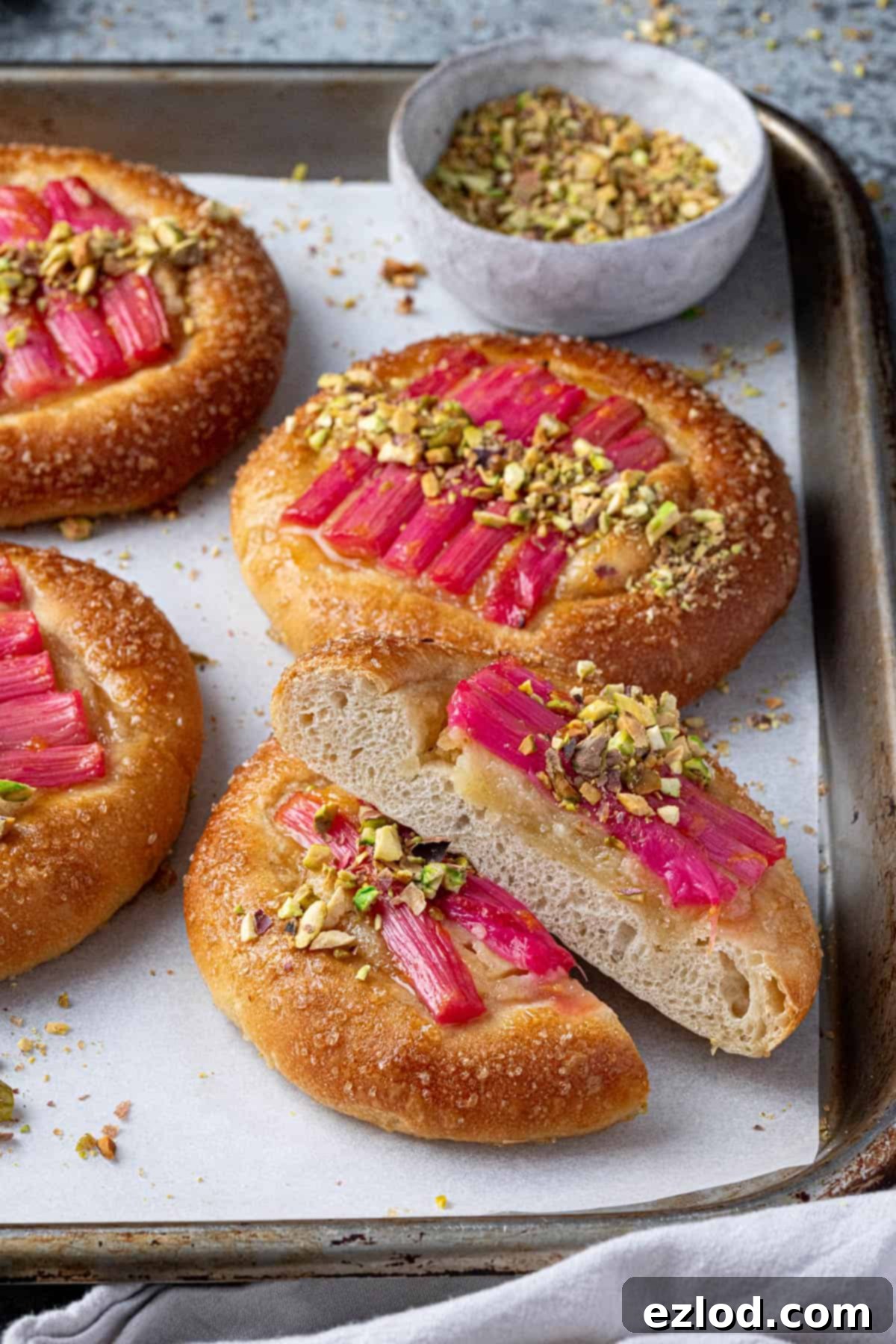
If you tried this recipe let me know how it went! Rate it, leave a comment or tag @domestic_gothess on Instagram and hashtag it #domesticgothess
All images and content on Domestic Gothess are copyright protected. If you want to share this recipe then please do so by using the share buttons provided. Do not screenshot or post the recipe or content in full, instead include a link to this post for the recipe.

Rhubarb Frangipane Buns (Vegan)
Ingredients
Tangzhong:
- 25 g (3 Tablespoons) white bread flour
- 140 ml (½ cup + 4 teaspoons) unsweetened non-dairy milk (I use soy)
Dough:
- all of the tangzhong
- 140 ml (½ cup + 4 teaspoons) unsweetened non-dairy milk (I use soy) cold
- 40 g (3 rounded Tablespoons) caster or granulated sugar
- 2 teaspoons vanilla extract
- 360 g (3 cups) white bread flour
- 1 teaspoon salt
- 7 g (1 sachet) fast action (instant) yeast
- 50 g (¼ cup) vegan butter softened
Rhubarb:
- 250 g (9 oz) forced rhubarb
- 25 g (2 Tablespoons) caster or granulated sugar
- juice of 1 small orange
Frangipane:
- 100 g (1 cup) ground almonds (almond flour)
- 30 g (¼ cup) plain (all-purpose) flour
- 10 g (1 Tablespoon) cornflour (cornstarch)
- ¼ teaspoon baking powder
- 70 g (⅓ cup) caster or granulated sugar
- 50 g (3 Tablespoons + 1 teaspoon) vegan block butter melted
- 50 ml (3 Tablespoons + 1 teaspoon) unsweetened non-dairy milk (I use soy)
- ½ teaspoon almond extract
To Finish:
- 1 Tablespoon non dairy milk
- 1 Tablespoon maple syrup
- demarera sugar for sprinkling
- chopped roasted pistachios optional
Instructions
-
To make the tangzhong, place the flour in a saucepan and gradually whisk in the milk to avoid lumps.
-
Place the pan over a medium/low heat and whisk constantly until the mixture has thickened to a paste/pudding-like consistency.
-
Scrape the tangzhong into the bowl of a stand mixer fitted with a dough hook and pour the rest of the cold milk on top. This will cool the tangzhong down so that the heat doesn’t kill the yeast.
-
Add the vanilla, sugar, salt and flour and finally the yeast. Stir until it forms a rough dough then set the stand mixer to a medium speed and mix until the dough is smooth and stretchy, this can take about 10 minutes.
-
Add the vegan butter and knead for about another 5 minutes until it is fully incorporated and the dough is smooth, elastic and no longer feels greasy. You may need to scrape down the sides of the bowl a couple of times.
-
The dough should still be soft and sticky, but it should pull away from the sides of the bowl cleanly. If it seems too wet then you can knead in a little extra flour, a tablespoon at a time. Be careful though, this is meant to be a soft dough and adding too much extra flour will make the bread dry.
-
Place the dough in a lightly oiled bowl, cover and place in the fridge to rise overnight, or in a warm spot for 1-2 hours, until doubled in size.
-
Whilee the dough is rising, heat the oven to 180℃/160℃ fan/350℉/gas mark 4. Cut the rhubarb into approximately 7cm long pieces and arrange them in a single layer in a roasting tin. Sprinkle with the sugar and pour over the orange juice. Roast for 10 minutes until softened but still holding their shape. Set aside to cool.
-
Punch down the risen dough and give it a brief knead to knock out any air bubbles. Divide it into 10 even pieces (use a scale for accuracy) and roll them into balls.
-
On a lightly floured surface, use your hands to flatten each ball into a disc about 10cm wide, then use your fingers or the base of a glass to flatten the middle section of the disc even further, leaving an approx 2 cm rim around the edge.
-
Place the discs well spaced apart on two lined baking sheets. Loosely cover and leave to rise until puffy, about 30-45 minutes. If you gently press the dough with your finger it should spring back slowly, and maybe leave a slight indentation. If it springs back quickly then it needs a little longer, and if the dough deflates then it is over-prooved so keep an eye on it!
-
While the buns are rising make the frangipane. Stir together the ground almonds, flour, cornflour, baking powder and sugar. Add the melted butter, milk and almond extract and stir with a balloon whisk until combined.
-
Once the buns are done rising, divide the frangipane between them, spooning it into the hollows and spreading it level.
-
Top the frangipane with the rhubarb, reserving the juices for later. Mix together the milk and maple syrup then gently brush this mixture on the exposed rim of dough. Sprinkle with demarera sugar.
-
Bake the buns for 20-25 minutes until nicely browned.
-
While the buns are baking, pour the reserved rhubarb juice into a small pan and bring up to a simmer. Cook for a few minutes until it has reduced slightly then remove from the heat.
-
Gently slide the baked buns onto a wire cooling rack and brush the rhubarb with the syrup. Sprinkle with chopped pistachios if you like and serve asap.
Notes
- See post above for tips, details and step-by-step photos. If you have a question about the recipe I may have already answered it above!
- As with all of my baking recipes I really do recommend using the metric measurements with a digital scale rather than the cup conversions. Cups are a wildly inaccurate measuring system and you will get far better, more consistent results using a scale, not to mention that it is also easier and less messy than cups!
- Be careful not to overcook the rhubarb otherwise it may fall apart and be difficult to decorate the buns with.
